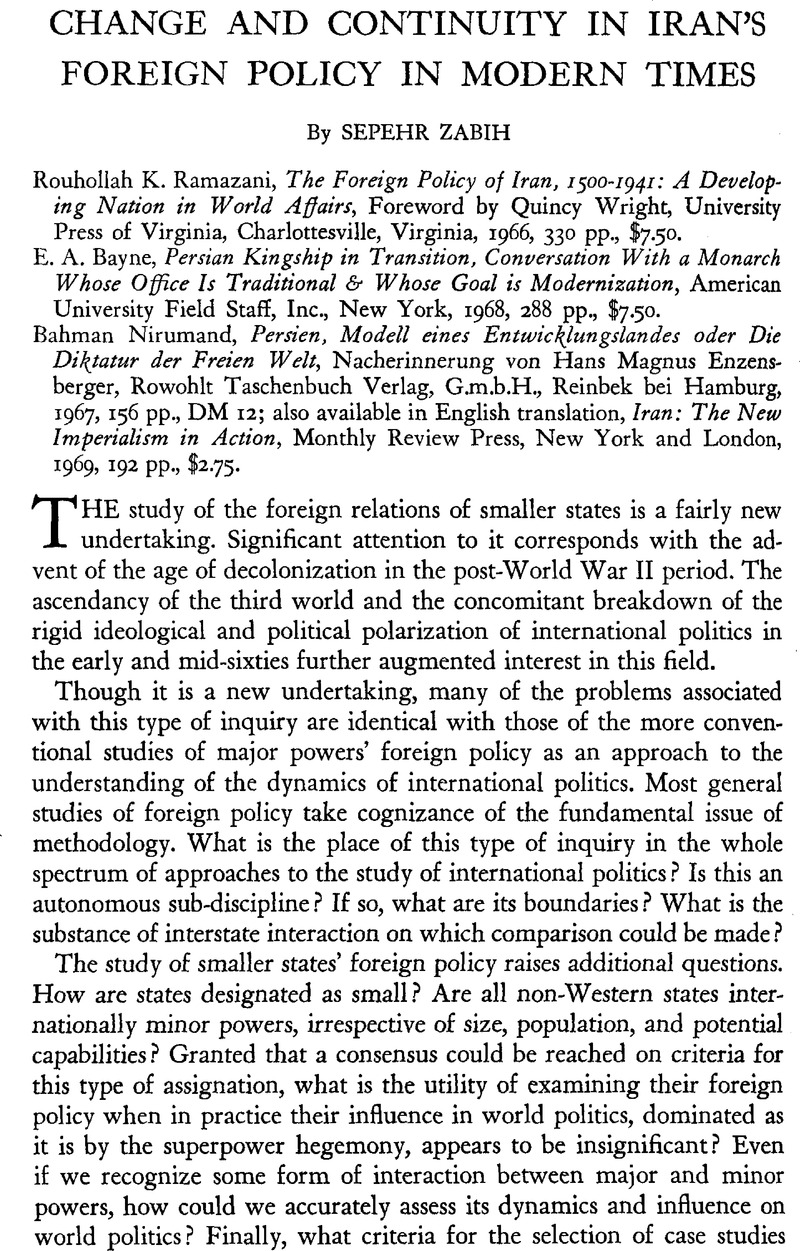Article contents
Change and Continuity in Iran's Foreign Policy in Modern Times
Review products
Published online by Cambridge University Press: 18 July 2011
Abstract

- Type
- Review Article
- Information
- Copyright
- Copyright © Trustees of Princeton University 1971
References
1 Black, Joseph E. and Thompson, Kenneth W., Foreign Policies in a World of Change (New York 1963Google Scholar).
2 Macridis, Roy C., ed., Foreign Policy in World Politics (Englewood Cliffs, N.J. 1964Google Scholar).
3 The non-Western states covered in these volumes are: Japan, India, Pakistan, China, Turkey, Egypt, Tunisia, Nigeria, East African countries, and Mexico.
4 Wilkinson, David O., Comparative Foreign Relations: Framework and Methods (Belmont, California 1969Google Scholar).
5 Quoting from Annette Baker Fox, the author attributes the lack of attention to small states to the traditional great-power stereotype of them as helpless pawns, and to the latters' conception of great states as cynical manipulators of power. The Power of Small States: Diplomacy in World War II (Chicago 1959), 1–2Google Scholar.
6 Snyder, Richard C., Bruch, H. W., and Sapin, Burton, eds., Foreign Policy Decision-making (New York 1962), 101Google Scholar.
7 Hoffmann, Stanley H., ed., Contemporary Theory in International Relations (Engle-wood Cliffs, N.J. 1964), 34–36Google Scholar.
8 For an analysis of the use of this technique in this episode see my book, The Communist Movement in Iran (Berkeley 1966), 107Google Scholar–22.
9 These are: Mostafa Fateh, Panjah Sal Nafte Iran [Fifty Years of Persian Oil] (Teheran 1956), Elwell-Sutton's, L. P.Persian Oil: A Study in Power Politics (London 1955Google Scholar) Ford's, Alan W.The Anglo-Iranian Oil Dispute of 1951–1952: A Study of the Role of Law in Relations of States (Berkeley and Los Angeles 1954Google Scholar).
10 See Ruznamehe Rasmi Keshvar [Official Gazette], “14th and 15th Majlis,” (Teheran 1943–1945).
11 One such series of which the author has made only scant use is Ebrahim Khaje-nouri, Bazigarane Asre Talai [The Performers of the Golden Age] (Teheran 1942-)
12 Noteworthy among these are: M. S. Ivanov, Ocherk. istorii Irana [Sketches of Iran's History] (Moscow 1952); P. Milov, Iran vo Vremya i Poslie vtoroy Mirovoy voyny [Iran During and After World War II] (Moscow 1949); M. Pavlovich and S. Irankii, Persia v Bor'ba za Nezavisimost [Persia and the Struggle for Independence] (Moscow 1925); Ye. L. Shteynberg, Sovestsko-lranskiye otnosheniya i proiski Anglo-Amenkanskogo imperializa v Irane [Soviet-Iranian Relations and the Intrigues of Anglo-American Imperialism in Iran] (Moscow 1947); and Gurko-Kryazhin, Kratkaya istoriya Persii [Short History of Persia] (Moscow 1925).
13 See my “Iran's International Posture: De facto Nonalignment Within a Pro-Western Alliance,” Middle East Journal, xxiv (Summer 1970Google Scholar).
14 These are: Lenczowski, George, Russia and the West in Iran 1918–1948: A Study in Big Power Rivalry (Ithaca 1962Google Scholar); Geyer, Dietrich, Die Sowjetunion und Iran: Eine Untersuchung zur Aussenpolitik der UdSSR in Naken Osten, 1917–1954 (Tubingen 1955Google Scholar); Hamzavi, Abdolhossein, Persia and the Powers: An Account of Diplomatic Relations, 1941–1946 (London 1947Google Scholar); Steppat, Fritz, Iran zwischen den Grossmachten, 1941–1948 (Oberursel 1948Google Scholar), Manshur, Mohammad Ali, Siyasate Dowlate Shoravi dar Iran az 1296 ta 1306 [The Soviet Policy in Iran, 1917–1927] (Teheran 1948Google Scholar); and Bahar, Mehdi, Siyasate Amrika dar Khavare Miyaneh [The U.S. Policy in the Middle East] (Teheran 1961Google Scholar).
15 Since 1950 the U.S. has supplied on grant or purchase basis approximately $1.6 billion of arms and $700 million of economic aid.
16 See for example his address on the anniversary of Dr. Mossadegh's overthrow in Keyhan International (Teheran, August 19, 1965).
17 Ibid., 219.
18 Another point of misgiving with the U.S. was the congressional clamor over the Shah's dispatch of a squadron of U.S. made F86 jets to Pakistan at the height of the Kashmir War. See Hearing before Senate Sub-committee on Near Eastern and South Asian Affairs of Committee of Foreign Relations, U.S. Senate, 90th Congress, March 14, April 13–20 and 25, June 22, 1967.
19 For a critical discussion of this see Binder, Leonard, Iran, Political Development in a Changing Society (Berkeley 1962Google Scholar).
20 For a comprehensive and sympathetic analysis see Cottam, Richard, Nationalism in Iran (Pittsburgh 1964Google Scholar).
21 The late Seyd Zia Tabatabi has been credited for strongly counselling the Shah to proceed on a policy of rapprochement with the Soviet Union. Avery, Peter, Modern Iran (New York 1965Google Scholar).
22 In an appeal to the sovereign the veteran statesman pleaded against the proposed amendment on the ground that it would undermine the authority of the Majlis, whose treaty-making power has enabled the country to resist pressures from major powers on several critical matters like the Anglo-Iranian treaty of 1919 and the Irano-Soviet oil agreement that he himself had negotiated with Russia in 1945. Demokrate Iran (Iranian Daily, March 1949).
23 This is almost identical with Communist literature of this period such as Bozorg Alavi's Kdmpjendes Iran (Berlin 1959Google Scholar).
24 Although they are not identified as such, most of his sources in this part are well known Communist literature like Donia, the organ of the Tudeh party in exile.
25 For a non-Communist analysis of U.S. economic aid to Iran see Amuze-gar, Jahangir, Technicial Assistance in Theory and Practice: The Case of Iran (New York 1966Google Scholar).
26 Forthcoming volumes in these series include The Foreign Relations of India, U.A.R., and the Arab Middle East and a number of other non-Western states.
27 Factors Influencing Iran's International Role, The RAND Corporation, RM-5668-F.F. (Santa Monica 1969).
- 2
- Cited by


